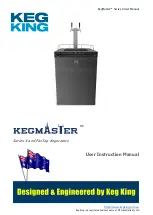
14
1.4. SELECTING THE PROPER ELECTRODE
There is no golden rule that determine the exact rod or heat setting required for every situation. The type
and thickness of metal and the position of the work piece determine the electrode type and the amount
of heat needed in the welding process. Heavier and thicker metals required more amperage. It is best to
practice your welds on scrap metal which matches the metal you intend to work with to determine correct
heat setting and electrode choice. See the following helpful trouble shooting tips to determine if you are
using a correct electrode.
1.4.1. When proper rod is used:
1.4.1.a. The bead will lay smoothly over the work without ragged edges
1.4.1.b. The base metal puddle will be as deep as the bead that rises above it
1.4.1.c. The welding operation will make a crackling sound similar to the sound of eggs frying
1.4.2. When a rod too small is used;
1.4.2. a. The bead will be high and irregular
1.4.2. b. The arc will be difficult to maintain
1.4.3. When the rod is too large
1.4.3. a. The arc will burn through light metals
1.4.3. b. The bead will undercut the work
1.4.3. c. The bead will be flat and porous
1.4.3. d. Rod may be freeze or stick to work piece
Note:
Rate of travel over the work also affects the weld. To ensure proper penetration and enough
deposit of rod, the arc must be moved slowly and evenly along the weld seam.
1.5.SETTING THE AMPERAGE CONTROL
The welder has an infinite current control. It is capable of welding with electrodes up to 3/32” diameter.
There is no golden rule that determines the exact amperage required for every situation. It is best to
practice your welds on scrap metal which matches the metals you intend to work with to determine
correct setting for your job. The electrode type and the thickness of the work piece metal determine the
amount of heat needed in the welding process. Heavier and thicker metals require
more voltage (amperage), whereas lighter and thinner metals require less voltage (amperage). Consult
the welding electrode packaging for recommended welding amperage range.
1.6. WELDING TECHNIQUES
The best way to teach yourself how to weld is with short periods of practice at regular intervals. All
practice welds should be done on scrap metal that can be discarded. Do not attempt to make any repairs
on valuable equipment until you have satisfied yourself that your practice welds are of good appearance
and free of slag or gas inclusions.
Summary of Contents for POWERTIG 300DPIII
Page 23: ...23 The Circuit Chart ...
Page 24: ...24 ...










































